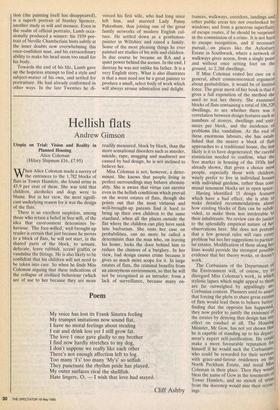Hellish flats
Andrew Gimson
Utopia on Trial: Vision and Reality in Planned Housing Alice Coleman (Hilary Shipman £16, £7.95)
When Alice Coleman made a survey of the entrances to the 1,782 blocks of flats in Tower Hamlets, she found urine in 43.9 per cent of them. She was told that children, alcoholics and dogs were to blame. But in her view, the most signifi- cant underlying reason for it was the design of the flats.
There is an excellent suspicion, among those who retain a belief in free will, of the idea that environment determines be- haviour. The free-willed, well-brought-up reader is certain that just because he moves to a block of flats, he will not start, in the shared parts of the block, to urinate, defecate, leave rubbish, scrawl graffiti or vandalise the fittings. He is also likely to be confident that his children will not need to be taken into care. So when he finds Miss Coleman arguing that these indications of the collapse of civilised behaviour (which are of use to her because they are more readily measured, block by block, than the more sensational disorders such as murder, suicide, rape, mugging and madness) are caused by bad design, he is not inclined to believe her.
Miss Coleman is not, however, a deter- minist. She knows that people living in perfect surroundings may behave abomin- ably. She is aware that virtue can survive even in the hellish conditions which prevail on the worst estates of flats, though she points out that the most virtuous and well-brought-up parents find it hard to bring up their own children to the same standard, when all the places outside the flat where the children can play have sunk into barbarism. She rests her case on probabilities, can no more be called a determinist than the man who, on leaving his home, locks the door behind him to reduce the chances of a burglary. In her view, bad design causes crime because it gives so much more scope for it. In large estates of flats, the criminal benefits from an anonymous environment, so that he will not be recognised as an intruder; from a lack of surveillance, because many en-
trances, walkways, corridors, landings and other public areas are not overlooked by windows; and from a generous superfluity of escape routes, if he should be surprised in the commission of a crime. It is not hard to escape recognition, and if necessary pursuit, on places like the Aylesbury Estate in Southwark, where a network of walkways gives access, from a single point and without once setting foot on the ground, to 2,268 dwellings.
If Miss Coleman rested her case on a general, albeit commonsensical argument about probabilities, it would be of limited force. The great merit of her book is that it gives a full exposition of the method she used to test her theory. She examined blocks of flats containing a total of 106,520 dwellings, to see whether there was a correlation between design features such as numbers of storeys, dwellings and entr- ances per block, and the incidence of problems like vandalism. At the end of these enormous labours, she has estab- lished that the nearer a block of flats approaches to a traditional house, the less likely is it to have degenerated; the careful statistician needed to confirm, what the free market in housing of the 1930s had already shown, that given a choice most people, especially those with children, wisely prefer to live in individual houses with individual gardens, rather than coin' munal tenement blocks set in open space.
Having identified 15 design features which have a bad effect, she is able to make detailed recommendations about how existing blocks of flats can be subdi- vided, to make them less intolerable to their inhabitants. No review can do justice to the splendidly empirical nature of her observations here. She does not pretend that a few general rules will cure every problem but ties her suggestions to particu- lar estates. Modification of these along her lines would provide the strongest possible evidence that her theory works, or doesnt work. The Corbusians of the Department Of the Environment will, of course, try to disregard Miss Coleman's work, in which stylistic lapses which might appeal to them are far outweighed by appallingly up' Corbusian content. Planners used to assert that forcing the plebs to share great estate of flats would lead them to behave better: finding that the opposite has happened; they now prefer to justify the existence of the estates by denying that design has any effect on conduct at all. The Housin8 Minister, Mr Gow, has not yet shown that he is capable of standing up to his depart', ment's expert self-justification. He could make a more favourable reputation for himself if he would sack the Corbusians, who could be rewarded for their services with grace-and-favour residences on the North Peckham Estate, and instal Miss Coleman in their place. Then they woulu, bless the name of Gow in the tenements of Tower Hamlets, and no stench of urine from the doorstep would mar their rejoic' ings.














































 Previous page
Previous page